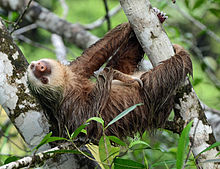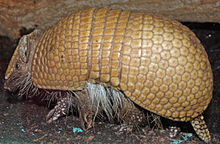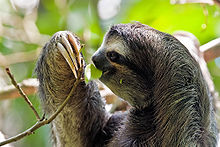Xenarthra
| Xenarthrans Temporal range: Paleocene –Recent,
| |
|---|---|

| |
| Hoffmann's two-toed sloth (Choloepus hoffmanni) | |
| Scientific classification | |
| Domain: | Eukaryota |
| Kingdom: | Animalia |
| Phylum: | Chordata |
| Class: | Mammalia |
| Infraclass: | Placentalia |
| Superorder: | Xenarthra Cope, 1889 |
| Orders and suborders | |
| |
The superorder Xenarthra is a group of placental mammals, extant today only in the Americas and represented by anteaters, tree sloths, and armadillos. The origins of the order can be traced as far back as the Paleocene, as early as 59 million years ago in South America.[1] Xenarthrans developed and diversified extensively in South America during its long period of isolation in the early to mid Cenozoic Era. They had invaded the Antilles by the early Miocene and, starting about 9 Mya, spread to Central and North America as part of the Great American Interchange.[2] Nearly all of the formerly abundant megafaunal xenarthrans, such as ground sloths, glyptodonts, and pampatheres, became extinct at the end of the Pleistocene.
Xenarthrans share several characteristics not present in other placental mammals. The name Xenarthra, which means "strange joints", was chosen because their vertebral joints have extra articulations unlike other mammals. This trait is referred to as "xenarthry". Also, unlike other mammals, the ischium and sacrum are fused.[3] The males have internal testicles, which are located between the bladder and the rectum.[4] Furthermore, xenarthrans have the lowest metabolic rates among the therians.[5][6]
Evolutionary relationships

Xenarthrans were previously classified alongside the pangolins and aardvarks in the order Edentata (meaning toothless, because the members do not have front incisor teeth and lack, or have poorly developed, molars). Subsequently, Edentata was found to be a polyphyletic grouping whose New World and Old World taxa are unrelated, and it was split up to reflect their true phylogeny. Aardvarks and pangolins are now placed in individual orders, and the new order Xenarthra was erected to group the remaining families (which are all related). The name Xenarthra means "strange joints", and was chosen because their vertebral joints have extra articulations and are unlike those of any other mammals. The morphology of xenarthrans generally suggests that the anteaters and sloths are more closely related to each other than either is to the armadillos; this is upheld by molecular studies. Since its conception, Xenarthra has increasingly come to be considered to be of a higher rank than 'order'; some authorities consider it to be a cohort, while others consider it to be a superorder. Whatever the rank, Xenarthra is now generally considered to be divided into two orders: Cingulata, which contains the armadillos; and Pilosa, which contains the Vermilingua (anteaters) and Folivora (sloths; previously known as Tardigrada or Phyllophaga).
Xenarthra may be most closely related to either Afrotheria[7] (in the group Atlantogenata), Boreoeutheria (in the group Exafroplacentalia), or Epitheria[8] (comprising Afrotheria and Boreoeutheria). In other words, it may be nested within Eutheria or it may be the basal extant group. A comprehensive phylogeny by Goloboff et al.[9] includes xenarthrans as a sister clade of Euarchontoglires within Boreoeutheria (Laurasiatheria+Euarchontoglires).
Phylogeny
Below is a recent simplified phylogeny of the xenarthran families based on Slater et al. (2016)[10] and Delsuc et al. (2016).[11]
| Xenarthra | |
Classification





XENARTHRA
- Order Cingulata
- Family Chlamyphoridae: armadillos and glyptodonts
- Greater fairy armadillo, Calyptophractus retusus
- Pink fairy armadillo, Chlamyphorus truncatus
- Northern naked-tailed armadillo, Cabassous centralis
- Chacoan naked-tailed armadillo, Cabassous chacoensis
- Southern naked-tailed armadillo, Cabassous unicinctus
- Greater naked-tailed armadillo, Cabassous tatouay
- Screaming hairy armadillo, Chaetophractus vellerosus
- Big hairy armadillo, Chaetophractus villosus
- Andean hairy armadillo, Chaetophractus nationi
- Six-banded armadillo or yellow armadillo, Euphractus sexcinctus
- Giant armadillo, Priodontes maximus
- Southern three-banded armadillo, Tolypeutes matacus
- Brazilian three-banded armadillo, Tolypeutes tricinctus
- Pichi or dwarf armadillo, Zaedyus pichiy
- Subfamily †Glyptodontinae: glyptodonts
- Family Dasypodidae: long-nosed armadillos
- Nine-banded armadillo or long-nosed armadillo, Dasypus novemcinctus
- Seven-banded armadillo, Dasypus septemcinctus
- Southern long-nosed armadillo, Dasypus hybridus
- Llanos long-nosed armadillo, Dasypus sabanicola
- Great long-nosed armadillo, Dasypus kappleri
- Hairy long-nosed armadillo, Dasypus pilosus
- Yepes's mulita, Dasypus yepesi
- Family †Pampatheriidae: pampatheres
- Family Chlamyphoridae: armadillos and glyptodonts
- Order Pilosa
- Suborder Folivora : sloths
- Family Bradypodidae: three-toed sloths
- Pygmy three-toed sloth, Bradypus pygmaeus
- Brown-throated three-toed sloth, Bradypus variegatus
- Pale-throated three-toed sloth, Bradypus tridactylus
- Maned three-toed sloth, Bradypus torquatus
- Family Megalonychidae: two-toed sloths and extinct megalonychid ground sloths
- Hoffman's two-toed sloth, Choloepus hoffmanni
- Linnaeus's two-toed sloth or southern two-toed sloth, Choloepus didactylus
- Family †Megatheriidae: megatheriid ground sloths
- Family †Mylodontidae: mylodontid ground sloths
- Family †Nothrotheriidae: nothrotheriid ground sloths and aquatic sloths
- Family Bradypodidae: three-toed sloths
- Suborder Vermilingua : anteaters
- Family Cyclopedidae: silky anteaters
- Silky anteater, Cyclopes didactylus
- Family Myrmecophagidae: anteaters
- Giant anteater, Myrmecophaga tridactyla
- Northern tamandua, Tamandua mexicana
- Southern tamandua, Tamandua tetradactyla
- Family Cyclopedidae: silky anteaters
- Suborder Folivora : sloths
References
- ^ O'Leary, M. A.; Bloch, J. I.; Flynn, J. J.; Gaudin, T. J.; Giallombardo, A.; Giannini, N. P.; Cirranello, A. L. (2013). "The placental mammal ancestor and the post–K-Pg radiation of placentals". Science. 339 (6120): 662–667. doi:10.1126/science.1229237. PMID 23393258.
- ^ Woodburne, Michael O. (2010). "The Great American Biotic Interchange: Dispersals, Tectonics, Climate, Sea Level and Holding Pens". Journal of Mammalian Evolution. 17 (4): 245–264. doi:10.1007/s10914-010-9144-8. PMC 2987556. PMID 21125025.
- ^ Delsuc, Frédéric; Catzteflis, François M.; Stanhope, Michael J.; Douzery, Emmanuel J. P. (August 2001). "The evolution of armadillos, anteaters and sloths depicted by nuclear and mitochondrial phylogenies: implications for the status of the enigmatic fossil Eurotamandua" (PDF). Proc. R. Soc. Lond. B. 268 (1476): 1605–15. doi:10.1098/rspb.2001.1702. PMC 1088784. PMID 11487408.
- ^ Kleisner, K; Ivell, R; Flegr, J (2010). "The evolutionary history of testicular externalization and the origin of the scrotum" (PDF). Journal of biosciences. 35 (1): 27–37. doi:10.1007/s12038-010-0005-7. PMID 20413907.
- ^ Elgar, M. A.; Harvey, P. H. (1987). "Basal Metabolic Rates in Mammals: Allometry, Phylogeny and Ecology". Functional Ecology. 1 (1): 25–36. doi:10.2307/2389354. JSTOR 2389354.
- ^ Lovegrove, Barry G. (2000). "The Zoogeography of Mammalian Basal Metabolic Rate". The American Naturalist. 156 (2): 201–19. doi:10.1086/303383. JSTOR 3079219. PMID 10856202.
- ^ Murphy, W. J.; Pringle, T. H.; Crider, T. A.; Springer, M. S.; Miller, W. (2007). "Using genomic data to unravel the root of the placental mammal phylogeny". Genome Research. 17 (4): 413–21. doi:10.1101/gr.5918807. PMC 1832088. PMID 17322288.
- ^ Kriegs, Jan Ole; Churakov, Gennady; Kiefmann, Martin; Jordan, Ursula; Brosius, Jürgen; Schmitz, Jürgen (2006). "Retroposed Elements as Archives for the Evolutionary History of Placental Mammals". PLoS Biology. 4 (4): e91. doi:10.1371/journal.pbio.0040091. PMC 1395351. PMID 16515367.
{{cite journal}}: CS1 maint: unflagged free DOI (link) - ^ Goloboff, Pablo A.; Catalano, Santiago A.; Marcos Mirande, J.; Szumik, Claudia A.; Salvador Arias, J.; Källersjö, Mari; Farris, James S. (2009). "Phylogenetic analysis of 73 060 taxa corroborates major eukaryotic groups". Cladistics. 25 (3): 211–30. doi:10.1111/j.1096-0031.2009.00255.x.
- ^ Slater, G., Cui, P., Forasiepi, A. M., Lenz, D., Tsangaras, K., Voirin, B., ... & Greenwood, A. D. (2016). Evolutionary relationships among extinct and extant sloths: the evidence of mitogenomes and retroviruses. Genome biology and evolution, evw023.
- ^ Delsuc, F., Gibb, G. C., Kuch, M., Billet, G., Hautier, L., Southon, J., ... & Poinar, H. N. (2016). The phylogenetic affinities of the extinct glyptodonts. Current Biology, 26(4), R155-R156.
External links
- Wildman, Derek E.; Chen, Caoyi; Erez, Offer; Grossman, Lawrence I.; Goodman, Morris; Romero, Roberto (2006). "Evolution of the mammalian placenta revealed by phylogenetic analysis". Proceedings of the National Academy of Sciences. 103 (9): 3203–8. Bibcode:2006PNAS..103.3203W. doi:10.1073/pnas.0511344103. JSTOR 30048561. PMC 1413940. PMID 16492730.
- "Armadillos: Biology, Ecology and Images". Armadillo Online. November 2012. Retrieved January 2013.
{{cite web}}: Check date values in:|accessdate=(help)
